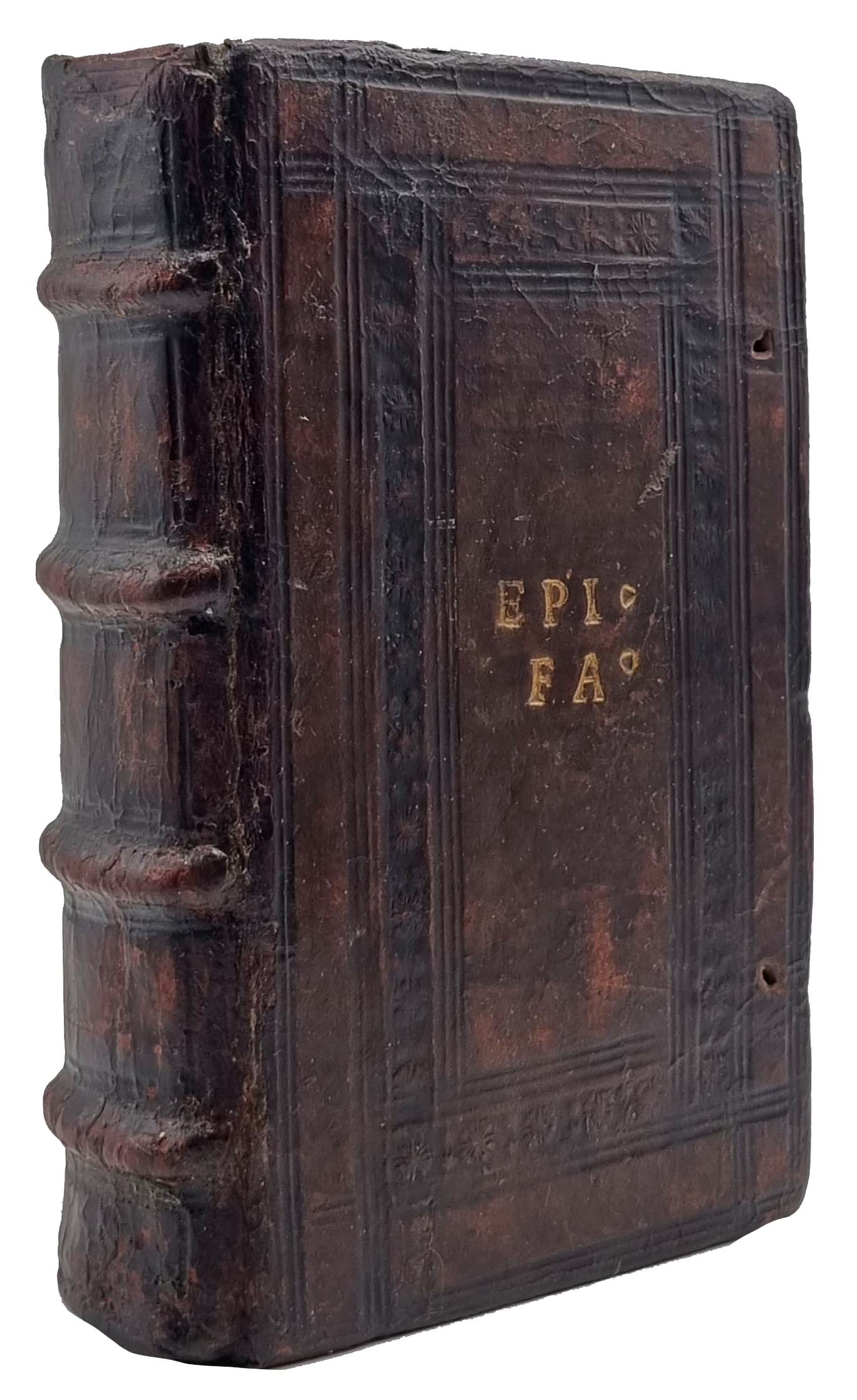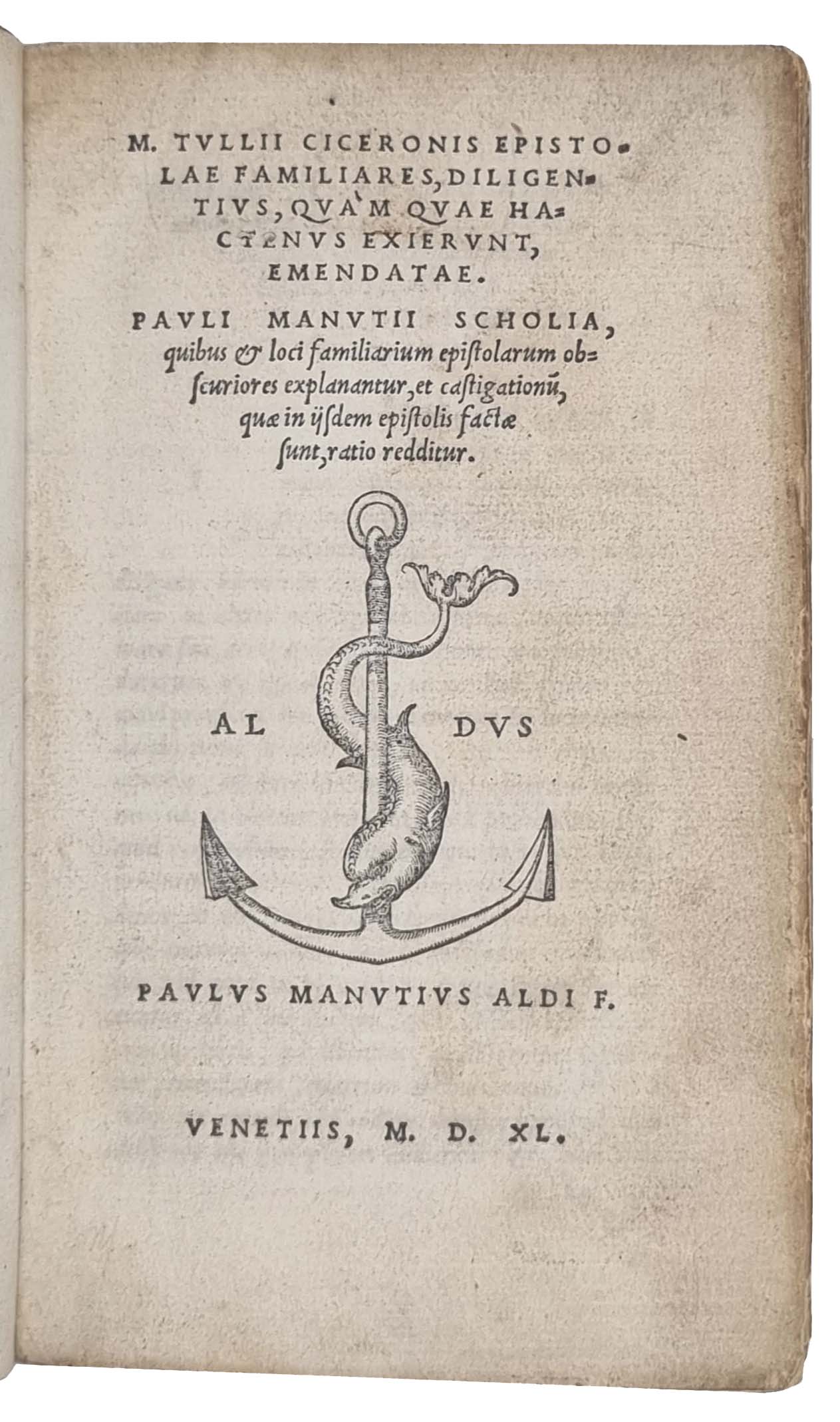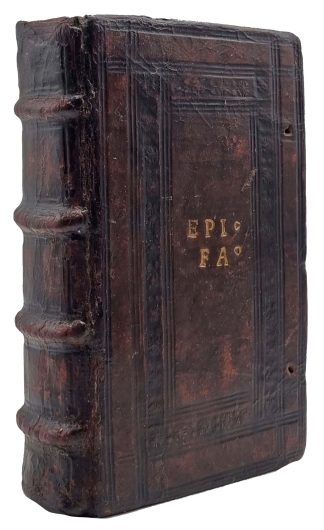CICERO
UNUSUAL CONTEMPORARY BINDING
Epistolae familiares (…) Pauli Manutii scholia
Venezia, Paolo Manuzio, 1540£9,500.00
8vo, two parts in one, FIRST EDITION of second, separate t-p to second, ff. (i) CCLXVII (l). Elegant italic letter, printer’s device to t-ps and versos of last. First t-p slightly dusty, minor tear from one lower outer blank corner, tiny wormtrail to upper blank margin of one gathering, intermittent extremely light waterstain to lower outer corner of a couple of final gatherings. A very good, clean copy in contemporary dark calf, covers triple blind ruled to a panel design, blind stamp roll of flowers and stars to inner border, early C17 “Epi(stolae) Fa(miliares)” gilt to upper cover and initials ‘T.F’ gilt to lower, spine with blind-ruled raised bands, crack to upper joint and head of spine repaired, missing ties, all edges gilt and gauffered with an intricate ropework pattern. Rare contemporary Latin marginalia and underlinings, occasional later marginalia (one in English).
Attractive and important Aldine edition of Cicero’s ‘Epistolae familiares’, the first to include Paulus Manutius’ scholia, in a contemporary probably French binding. Although the design of the blind stamped covers and the type of calf suggests an English or Flemish manufacture, the fine blind stamped roll and its numerous variations appear on bindings realised in Paris and the regions of eastern France during the first half of the 16th century (roll: see Gid., ‘Catalogue des reliures françaises’ Vol II, pl. 64-66; French bindings with the roll: Gid, Vol. I, no. 136-183, atelier: Paris; no. 61, atelier: Lyon; n. 178-179, atelier: Eastern France). The roll is not recorded by Oldham. Similar richly gilt and gauffered edges are found on southern European luxury volumes. The gilt title and the initials ‘T.F.’ are English in style; unfortunately, we were unable to uncover the identity of this early owner.
This edition of the epistles is the second by Paulus (first 1533), and it includes an entirely revised and improved text, new title, preface and a new remarkable 50-page detailed commentary (scholia). The youngest son of Aldus, Paulus (1512-1574) was an influential publisher and one of the most prominent humanists of the Late Italian Renaissance. He was especially engaged in Latin literature and his outstanding reputation as a scholar was built upon his editions and commentaries on the works of Cicero: “no man had a juster conception of the beauties of this great Roman orator and philosopher, and no man has more successfully imitated his style” (Dibdin).
‘Ad familiares’ (Letters to friends), in 16 books, is one of four collections of Cicero’s correspondence, first compiled and published by Cicero’s personal secretary Marcus Tullius Tiro. It includes letters between the celebrated orator and series of public (e.g. Pompey and Cesar) and private figures (e.g. Cicero’s wife Terentia). Among them is the famous letter of consolation from the consul Servius Sulpicius Rufus on the death of the orator’s daughter Tullia (Fam. IV, 5). Another one is from Cicero to Lucius Minucius Basilus, a conspirator in Caesar’s murder: “I congratulate you. I rejoice for myself. I love you. I watch your interests. I wish for your love and to be informed of what you are doing and what is being done” (Fam. VI. 15). ‘Ad familiares’ – together with ‘Ad Atticum’, ‘Ad Brutum’ and ‘At Quintum Fratrem’ – is among the most valuable sources of historical information on the years 68-43 BC, and there is no other period of antiquity for which we still possess such an immediate and intimate record and in such domestic detail. The vast corpus of Ciceronian Epistolae and Orationes was for a long time used as foundation texts in early modern schools.
The greatest orator of the Late Republic, Marcus Tullius Cicero (106-43BC) was a Roman statesman, lawyer and scholar. Although he was a ‘homo novus’, namely the first in his family to achieve public office, he soon became one of the leading political figures of the era of Julius Caesar, Pompey, Marc Antony and Octavian. Defined by Quintilian as ‘eloquence itself’, he put his legal skills to the service of politics.
USTC 822132; EDIT 16 CNCE 12247; Adams C1946; BM STC It. C16, p. 178; Brunet II, 46; Graesse II, p. 168; Dibdin I, p. 422; Renouard 120:6; Burgassi p. 81. D. Gid, Catalogue des reliures françaises estampées à froid XVe - XVIe siècle de la Bibliothèque Mazarine, 2 vols (1984).In stock







